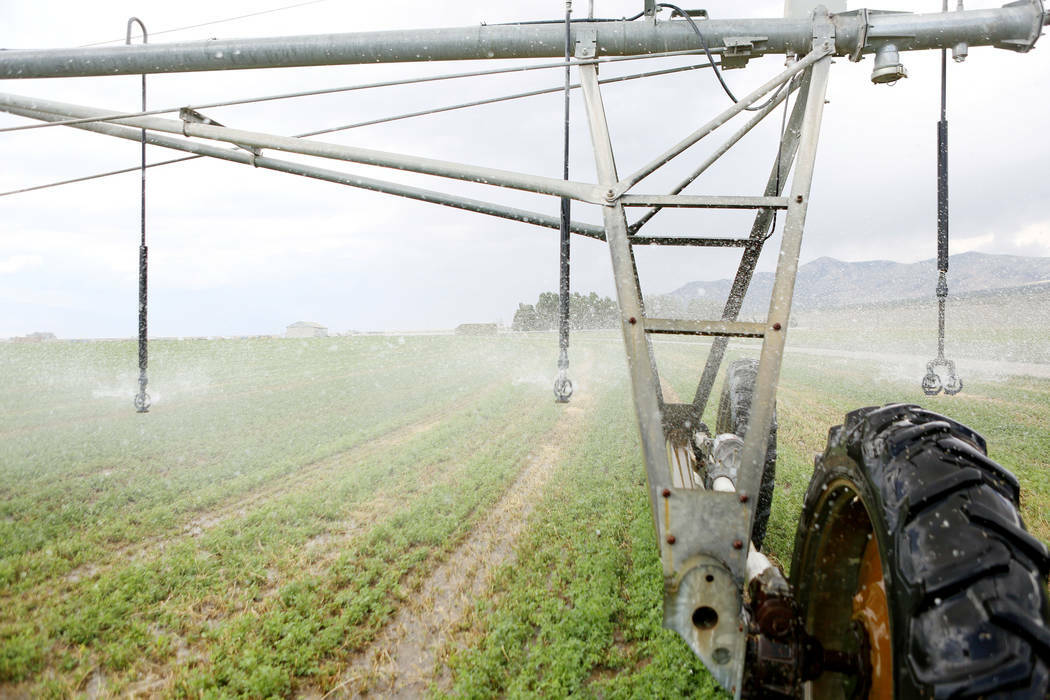COMMENTARY: One way to stretch Nevada’s dwindling water supplies

Farmers are the backbone of our country, and this is especially true for the Diamond Valley in Eureka County. This area is known for its production of crops such as wheat, oats and alfalfa hay, which contribute significantly to Nevada’s billion-dollar agricultural industry.
My family’s farming heritage in Diamond Valley began in the late 1970s when my father moved here to grow the area’s staple crop, alfalfa. Over the years, we purchased more land, growing our farm into one of the largest in the valley. Each new property came with water rights, vital to our farming operations. As we grew older, my sisters and I rejoined the family business, purchasing land from our parents and neighbors to continue our family’s legacy of growing crops to help feed American families.
Groundwater is disappearing across the country due to drought and warming temperatures. In Nevada, where farmers depend on groundwater to grow crops, more than half the wells are operating at maximum capacity. In some areas, the state has allocated groundwater rights that are up to three times the amount of water estimated to be available. A study by the Nature Conservancy in 2022 found that of the more than 6,500 wells analyzed in Nevada, 39 percent had significantly declining groundwater levels over the past several decades, showing the impacts of the overuse of water in some areas.
Water is the lifeblood of American agriculture. With groundwater levels decreasing and wells in Diamond Valley being heavily relied on or abandoned entirely for new sources, we knew we had to act quickly to conserve our resources. We transitioned our irrigation systems from hand and wheel lines to pivot irrigation systems, which improved water efficiency. We then retrofitted our pivots, bringing the sprinkler heads closer to the ground to cut water loss and improve efficiency.
Despite our efforts and those of our neighboring farms, the wells continued to dry, forcing farmers to drill deeper into the aquifers and costing farming families hundreds of thousands of dollars. In 2015, this came to a head when Diamond Valley was declared a “critical management area,” which required water users in the basin to create a plan to collectively lower their consumption or be forced to do so based on their water rights seniority. More than 70 percent of the irrigators signed off on the subsequent plan, allowing basin users to share the responsibility and voluntarily reduce water use over the next three decades.
My sisters and I had discussed purchasing a feed store for many years when the state launched its pilot program to buy rights from willing groundwater rights holders in areas such as Diamond Valley. I was hesitant. We grew up believing water was the land’s only value. My sister encouraged me to see this offer as a business opportunity.
Faced with the reality of the drying aquifers, I knew retiring water rights could benefit the farming community by lowering the overall burden on the aquifers and helping stabilize water levels. So we decided to retire some of our groundwater rights near wells with significantly lower water levels. We used the proceeds of the sale to purchase a local feed store, where we now sell hay and other locally grown products, most of which are produced by our family farm.
Some days, I’m still nervous about our decision, but I know the situation is urgent. Nevada is the driest state in the United States, averaging just more than 10 inches of precipitation per year. Temperatures across the state have risen almost 2.4 degrees since the early 20th century, intensifying drought conditions. Since my father purchased his first parcel of land in Nevada, average summertime temperatures in the state have increased significantly. Nevada has faced extended periods of severe drought. States across the American West need a plan to conserve water if we are to continue farming and living sustainably in this region. In Nevada, this could involve creating a program to purchase groundwater from farmers willing to retire their rights.
Groundwater rights retirement has been a widely discussed issue in the Legislature this session. Two bills — Senate Bill 36 and Assembly Billy 104 — recently passed the Natural Resources Committee work sessions. Reducing groundwater extraction through voluntary retirement programs can help stabilize levels, preserving this precious resource for future generations. Protecting our water resources can not only help support our state’s agricultural industry, but also boost our economy long-term by helping preserve our groundwater-dependent ecosystems, which are vital to Nevada’s $ 8.1 billion outdoor recreation industry that directly provides more than 58,000 jobs in the state. Financial support from voluntary groundwater rights retirement programs can also help farmers invest back into their businesses and transition to more sustainable practices without sacrificing their livelihoods.
Water rights were developed in good faith before farmers knew how fast-rising temperatures and population growth would impact our resources. A groundwater rights retirement program can help producers while also conserving water in the nation’s driest state. I urge support of SB36 and AB104. By balancing the needs of communities, agriculture and the environment, a groundwater rights retirement program can be another tool to help us achieve a more sustainable future for water in Nevada and, in turn, benefit all Nevadans.
Denise Moyle is a second-generation farmer in Diamond Valley.